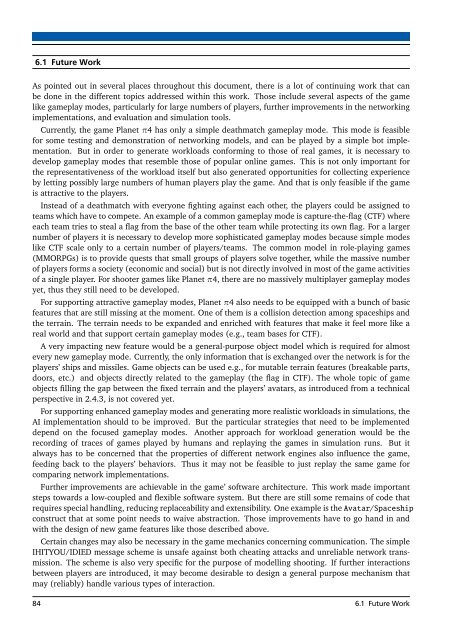Implementation of a Peer-to-Peer Multiplayer Game with ... - DVS
Implementation of a Peer-to-Peer Multiplayer Game with ... - DVS
Implementation of a Peer-to-Peer Multiplayer Game with ... - DVS
You also want an ePaper? Increase the reach of your titles
YUMPU automatically turns print PDFs into web optimized ePapers that Google loves.
6.1 Future WorkAs pointed out in several places throughout this document, there is a lot <strong>of</strong> continuing work that canbe done in the different <strong>to</strong>pics addressed <strong>with</strong>in this work. Those include several aspects <strong>of</strong> the gamelike gameplay modes, particularly for large numbers <strong>of</strong> players, further improvements in the networkingimplementations, and evaluation and simulation <strong>to</strong>ols.Currently, the game Planet π4 has only a simple deathmatch gameplay mode. This mode is feasiblefor some testing and demonstration <strong>of</strong> networking models, and can be played by a simple bot implementation.But in order <strong>to</strong> generate workloads conforming <strong>to</strong> those <strong>of</strong> real games, it is necessary <strong>to</strong>develop gameplay modes that resemble those <strong>of</strong> popular online games. This is not only important forthe representativeness <strong>of</strong> the workload itself but also generated opportunities for collecting experienceby letting possibly large numbers <strong>of</strong> human players play the game. And that is only feasible if the gameis attractive <strong>to</strong> the players.Instead <strong>of</strong> a deathmatch <strong>with</strong> everyone fighting against each other, the players could be assigned <strong>to</strong>teams which have <strong>to</strong> compete. An example <strong>of</strong> a common gameplay mode is capture-the-flag (CTF) whereeach team tries <strong>to</strong> steal a flag from the base <strong>of</strong> the other team while protecting its own flag. For a largernumber <strong>of</strong> players it is necessary <strong>to</strong> develop more sophisticated gameplay modes because simple modeslike CTF scale only <strong>to</strong> a certain number <strong>of</strong> players/teams. The common model in role-playing games(MMORPGs) is <strong>to</strong> provide quests that small groups <strong>of</strong> players solve <strong>to</strong>gether, while the massive number<strong>of</strong> players forms a society (economic and social) but is not directly involved in most <strong>of</strong> the game activities<strong>of</strong> a single player. For shooter games like Planet π4, there are no massively multiplayer gameplay modesyet, thus they still need <strong>to</strong> be developed.For supporting attractive gameplay modes, Planet π4 also needs <strong>to</strong> be equipped <strong>with</strong> a bunch <strong>of</strong> basicfeatures that are still missing at the moment. One <strong>of</strong> them is a collision detection among spaceships andthe terrain. The terrain needs <strong>to</strong> be expanded and enriched <strong>with</strong> features that make it feel more like areal world and that support certain gameplay modes (e.g., team bases for CTF).A very impacting new feature would be a general-purpose object model which is required for almostevery new gameplay mode. Currently, the only information that is exchanged over the network is for theplayers’ ships and missiles. <strong>Game</strong> objects can be used e.g., for mutable terrain features (breakable parts,doors, etc.) and objects directly related <strong>to</strong> the gameplay (the flag in CTF). The whole <strong>to</strong>pic <strong>of</strong> gameobjects filling the gap between the fixed terrain and the players’ avatars, as introduced from a technicalperspective in 2.4.3, is not covered yet.For supporting enhanced gameplay modes and generating more realistic workloads in simulations, theAI implementation should <strong>to</strong> be improved. But the particular strategies that need <strong>to</strong> be implementeddepend on the focused gameplay modes. Another approach for workload generation would be therecording <strong>of</strong> traces <strong>of</strong> games played by humans and replaying the games in simulation runs. But italways has <strong>to</strong> be concerned that the properties <strong>of</strong> different network engines also influence the game,feeding back <strong>to</strong> the players’ behaviors. Thus it may not be feasible <strong>to</strong> just replay the same game forcomparing network implementations.Further improvements are achievable in the game’ s<strong>of</strong>tware architecture. This work made importantsteps <strong>to</strong>wards a low-coupled and flexible s<strong>of</strong>tware system. But there are still some remains <strong>of</strong> code thatrequires special handling, reducing replaceability and extensibility. One example is the Avatar/Spaceshipconstruct that at some point needs <strong>to</strong> waive abstraction. Those improvements have <strong>to</strong> go hand in and<strong>with</strong> the design <strong>of</strong> new game features like those described above.Certain changes may also be necessary in the game mechanics concerning communication. The simpleIHITYOU/IDIED message scheme is unsafe against both cheating attacks and unreliable network transmission.The scheme is also very specific for the purpose <strong>of</strong> modelling shooting. If further interactionsbetween players are introduced, it may become desirable <strong>to</strong> design a general purpose mechanism thatmay (reliably) handle various types <strong>of</strong> interaction.84 6.1 Future Work















